key JEEP RENEGADE 2018 Owner handbook (in English)
[x] Cancel search | Manufacturer: JEEP, Model Year: 2018, Model line: RENEGADE, Model: JEEP RENEGADE 2018Pages: 356, PDF Size: 6.11 MB
Page 158 of 356
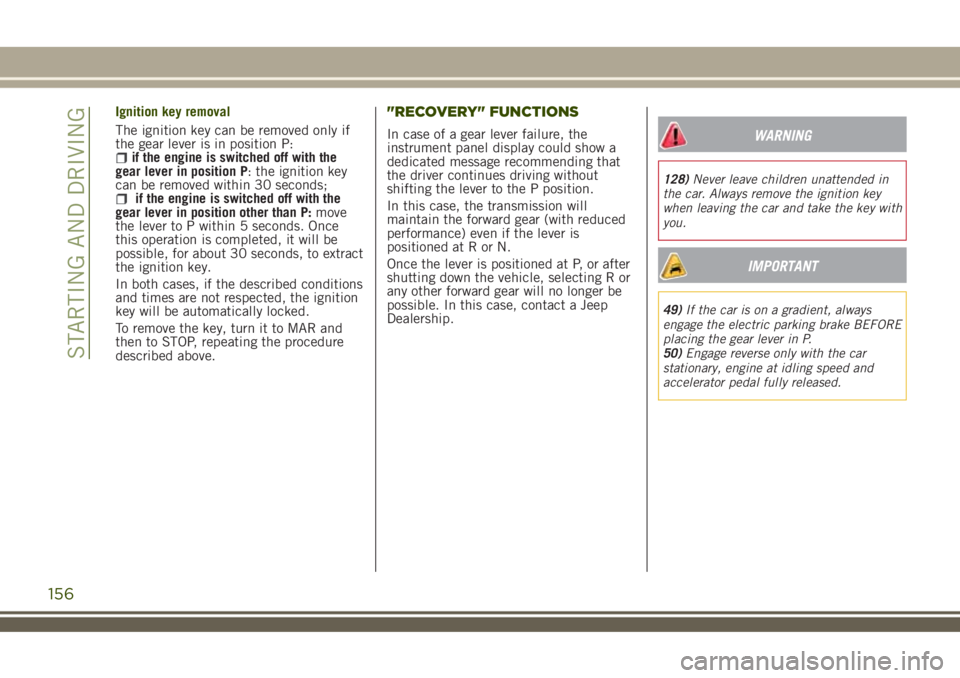
Ignition key removal
The ignition key can be removed only if
the gear lever is in position P:
if the engine is switched off with the
gear lever in position P: the ignition key
can be removed within 30 seconds;
if the engine is switched off with the
gear lever in position other than P:move
the lever to P within 5 seconds. Once
this operation is completed, it will be
possible, for about 30 seconds, to extract
the ignition key.
In both cases, if the described conditions
and times are not respected, the ignition
key will be automatically locked.
To remove the key, turn it to MAR and
then to STOP, repeating the procedure
described above.
"RECOVERY" FUNCTIONS
In case of a gear lever failure, the
instrument panel display could show a
dedicated message recommending that
the driver continues driving without
shifting the lever to the P position.
In this case, the transmission will
maintain the forward gear (with reduced
performance) even if the lever is
positioned at R or N.
Once the lever is positioned at P, or after
shutting down the vehicle, selecting R or
any other forward gear will no longer be
possible. In this case, contact a Jeep
Dealership.WARNING
128)Never leave children unattended in
the car. Always remove the ignition key
when leaving the car and take the key with
you.
IMPORTANT
49)If the car is on a gradient, always
engage the electric parking brake BEFORE
placing the gear lever in P.
50)Engage reverse only with the car
stationary, engine at idling speed and
accelerator pedal fully released.
156
STARTING AND DRIVING
Page 162 of 356
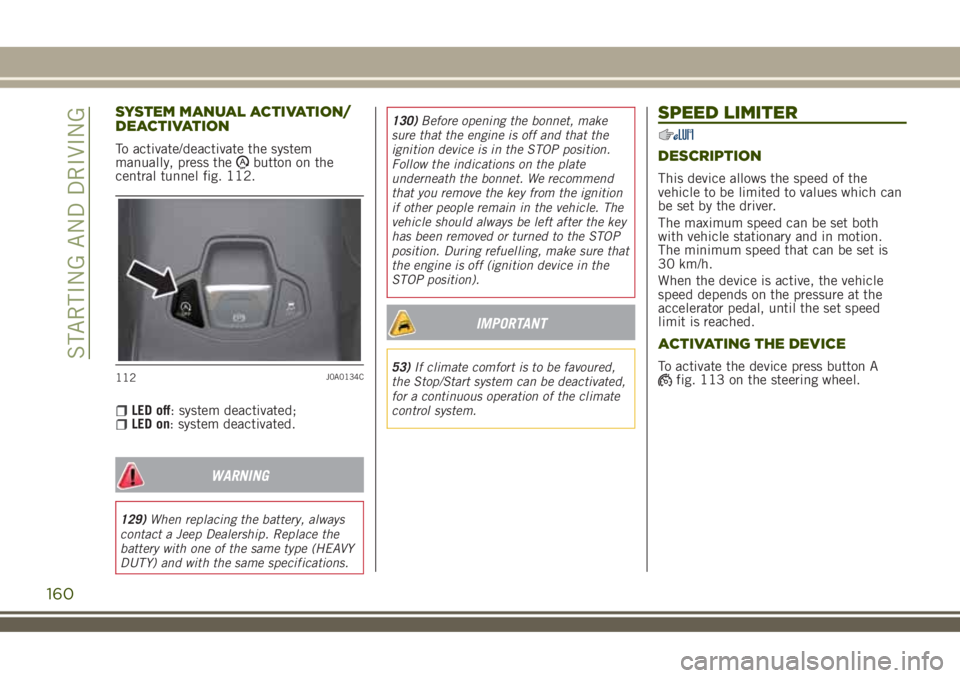
SYSTEM MANUAL ACTIVATION/
DEACTIVATION
To activate/deactivate the system
manually, press thebutton on the
central tunnel fig. 112.
LED off: system deactivated;LED on: system deactivated.
WARNING
129)When replacing the battery, always
contact a Jeep Dealership. Replace the
battery with one of the same type (HEAVY
DUTY) and with the same specifications.130)Before opening the bonnet, make
sure that the engine is off and that the
ignition device is in the STOP position.
Follow the indications on the plate
underneath the bonnet. We recommend
that you remove the key from the ignition
if other people remain in the vehicle. The
vehicle should always be left after the key
has been removed or turned to the STOP
position. During refuelling, make sure that
the engine is off (ignition device in the
STOP position).
IMPORTANT
53)If climate comfort is to be favoured,
the Stop/Start system can be deactivated,
for a continuous operation of the climate
control system.
SPEED LIMITER
DESCRIPTION
This device allows the speed of the
vehicle to be limited to values which can
be set by the driver.
The maximum speed can be set both
with vehicle stationary and in motion.
The minimum speed that can be set is
30 km/h.
When the device is active, the vehicle
speed depends on the pressure at the
accelerator pedal, until the set speed
limit is reached.
ACTIVATING THE DEVICE
To activate the device press button Afig. 113 on the steering wheel.112J0A0134C
160
STARTING AND DRIVING
Page 187 of 356
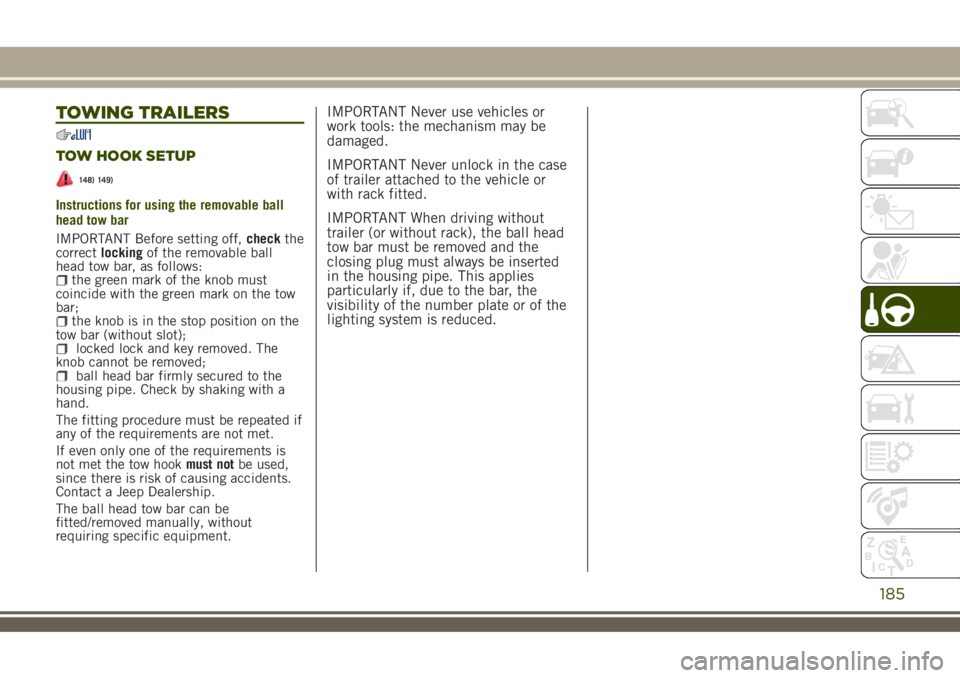
TOWING TRAILERS
TOW HOOK SETUP
148) 149)
Instructions for using the removable ball
head tow bar
IMPORTANT Before setting off,checkthe
correctlockingof the removable ball
head tow bar, as follows:
the green mark of the knob must
coincide with the green mark on the tow
bar;
the knob is in the stop position on the
tow bar (without slot);
locked lock and key removed. The
knob cannot be removed;
ball head bar firmly secured to the
housing pipe. Check by shaking with a
hand.
The fitting procedure must be repeated if
any of the requirements are not met.
If even only one of the requirements is
not met the tow hookmust notbe used,
since there is risk of causing accidents.
Contact a Jeep Dealership.
The ball head tow bar can be
fitted/removed manually, without
requiring specific equipment.
IMPORTANT Never use vehicles or
work tools: the mechanism may be
damaged.
IMPORTANT Never unlock in the case
of trailer attached to the vehicle or
with rack fitted.
IMPORTANT When driving without
trailer (or without rack), the ball head
tow bar must be removed and the
closing plug must always be inserted
in the housing pipe. This applies
particularly if, due to the bar, the
visibility of the number plate or of the
lighting system is reduced.
185
Page 189 of 356

Key
1 – Housing pipe
2 – Ball head tow bar
3 – Locking balls
4 – Release ball
5 – Release lever
6 – Knob
7 – Cap
8 – Key
9 – Red marking (knob)
10 – Green marking (knob)
11 – Green marking (tow bar)
12 – Symbol (control release)
13 – Closing cap
14 – Engagement pin
15 – Absence of slots between 2 and 6
16 – Slot of 5 mm approx.
A: locked position (driving)
B: released position (removed)
Tow hook trim
Before fitting the ball head tow bar, the
tow hook trim on the rear bumper must
be removed.
Trim removal: rotate devices A
fig. 138 90° towards the outside, as
indicated by the arrows. Then move them
upwards.Turn the trim to release it (1 – fig. 139 )
and slide it downwards (2) to remove it.Trim refitting: move devices A
fig. 140 downwards then turn them
90° towards the inside, as indicated by
the arrows.
138J0A0628C
139J0A0627C
187
Page 190 of 356
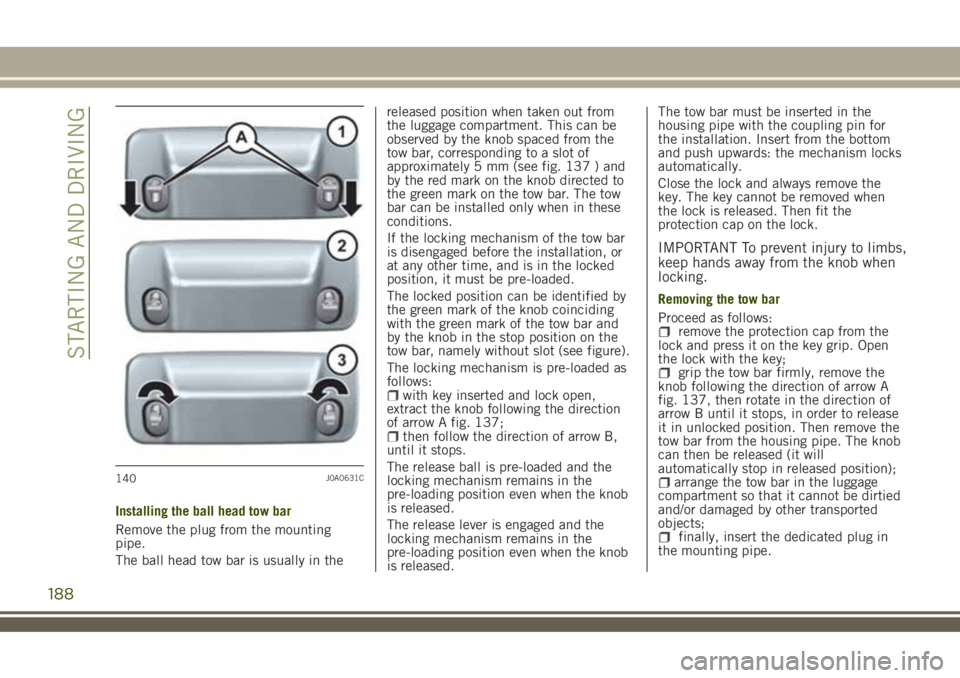
Installing the ball head tow bar
Remove the plug from the mounting
pipe.
The ball head tow bar is usually in thereleased position when taken out from
the luggage compartment. This can be
observed by the knob spaced from the
tow bar, corresponding to a slot of
approximately 5 mm (see fig. 137 ) and
by the red mark on the knob directed to
the green mark on the tow bar. The tow
bar can be installed only when in these
conditions.
If the locking mechanism of the tow bar
is disengaged before the installation, or
at any other time, and is in the locked
position, it must be pre-loaded.
The locked position can be identified by
the green mark of the knob coinciding
with the green mark of the tow bar and
by the knob in the stop position on the
tow bar, namely without slot (see figure).
The locking mechanism is pre-loaded as
follows:
with key inserted and lock open,
extract the knob following the direction
of arrow A fig. 137;
then follow the direction of arrow B,
until it stops.
The release ball is pre-loaded and the
locking mechanism remains in the
pre-loading position even when the knob
is released.
The release lever is engaged and the
locking mechanism remains in the
pre-loading position even when the knob
is released.The tow bar must be inserted in the
housing pipe with the coupling pin for
the installation. Insert from the bottom
and push upwards: the mechanism locks
automatically.
Close the lock and always remove the
key. The key cannot be removed when
the lock is released. Then fit the
protection cap on the lock.
IMPORTANT To prevent injury to limbs,
keep hands away from the knob when
locking.
Removing the tow bar
Proceed as follows:
remove the protection cap from the
lock and press it on the key grip. Open
the lock with the key;
grip the tow bar firmly, remove the
knob following the direction of arrow A
fig. 137, then rotate in the direction of
arrow B until it stops, in order to release
it in unlocked position. Then remove the
tow bar from the housing pipe. The knob
can then be released (it will
automatically stop in released position);
arrange the tow bar in the luggage
compartment so that it cannot be dirtied
and/or damaged by other transported
objects;
finally, insert the dedicated plug in
the mounting pipe.
140J0A0631C
188
STARTING AND DRIVING
Page 191 of 356
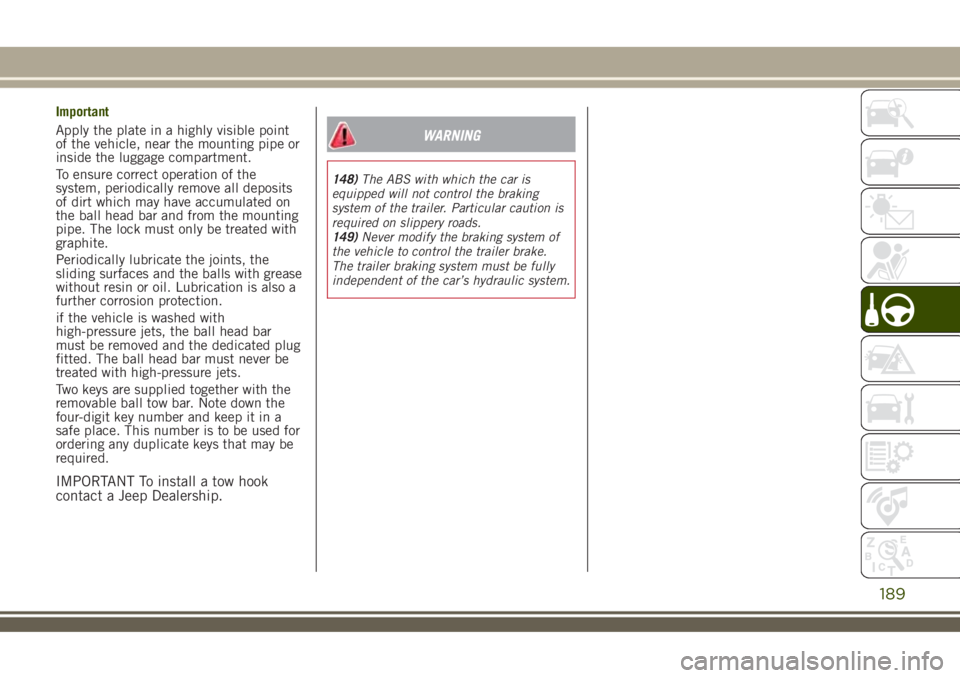
Important
Apply the plate in a highly visible point
of the vehicle, near the mounting pipe or
inside the luggage compartment.
To ensure correct operation of the
system, periodically remove all deposits
of dirt which may have accumulated on
the ball head bar and from the mounting
pipe. The lock must only be treated with
graphite.
Periodically lubricate the joints, the
sliding surfaces and the balls with grease
without resin or oil. Lubrication is also a
further corrosion protection.
if the vehicle is washed with
high-pressure jets, the ball head bar
must be removed and the dedicated plug
fitted. The ball head bar must never be
treated with high-pressure jets.
Two keys are supplied together with the
removable ball tow bar. Note down the
four-digit key number and keep it in a
safe place. This number is to be used for
ordering any duplicate keys that may be
required.
IMPORTANT To install a tow hook
contact a Jeep Dealership.
WARNING
148)The ABS with which the car is
equipped will not control the braking
system of the trailer. Particular caution is
required on slippery roads.
149)Never modify the braking system of
the vehicle to control the trailer brake.
The trailer braking system must be fully
independent of the car’s hydraulic system.
189
Page 211 of 356
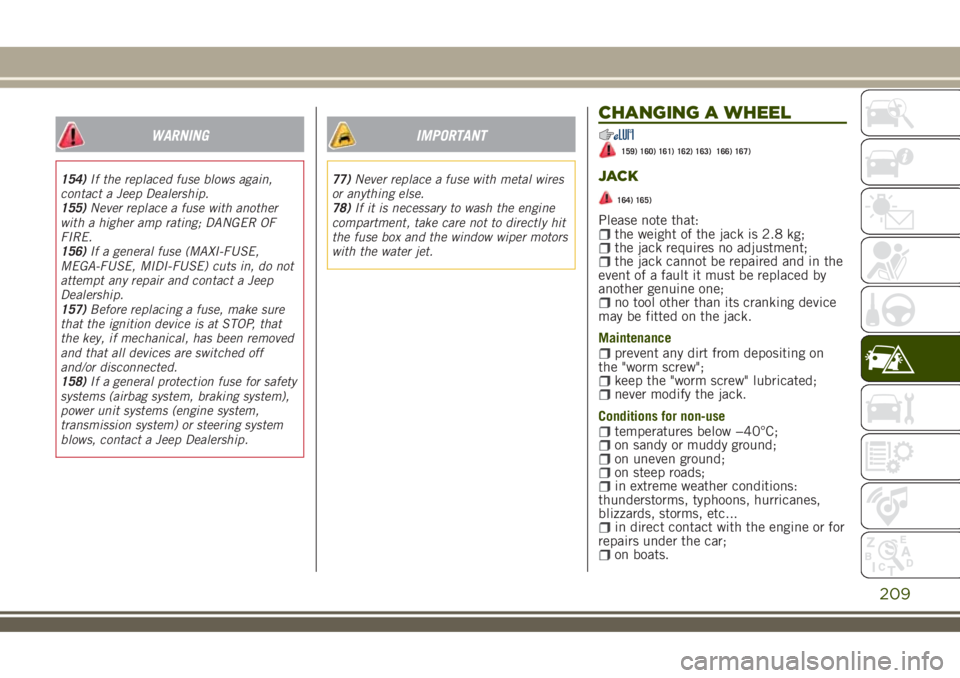
WARNING
154)If the replaced fuse blows again,
contact a Jeep Dealership.
155)Never replace a fuse with another
with a higher amp rating; DANGER OF
FIRE.
156)If a general fuse (MAXI-FUSE,
MEGA-FUSE, MIDI-FUSE) cuts in, do not
attempt any repair and contact a Jeep
Dealership.
157)Before replacing a fuse, make sure
that the ignition device is at STOP, that
the key, if mechanical, has been removed
and that all devices are switched off
and/or disconnected.
158)If a general protection fuse for safety
systems (airbag system, braking system),
power unit systems (engine system,
transmission system) or steering system
blows, contact a Jeep Dealership.
IMPORTANT
77)Never replace a fuse with metal wires
or anything else.
78)If it is necessary to wash the engine
compartment, take care not to directly hit
the fuse box and the window wiper motors
with the water jet.
CHANGING A WHEEL
159) 160) 161) 162) 163) 166) 167)
JACK
164) 165)
Please note that:the weight of the jack is 2.8 kg;the jack requires no adjustment;the jack cannot be repaired and in the
event of a fault it must be replaced by
another genuine one;
no tool other than its cranking device
may be fitted on the jack.
Maintenance
prevent any dirt from depositing on
the "worm screw";
keep the "worm screw" lubricated;never modify the jack.
Conditions for non-use
temperatures below −40°C;on sandy or muddy ground;on uneven ground;on steep roads;in extreme weather conditions:
thunderstorms, typhoons, hurricanes,
blizzards, storms, etc...
in direct contact with the engine or for
repairs under the car;
on boats.
209
Page 213 of 356
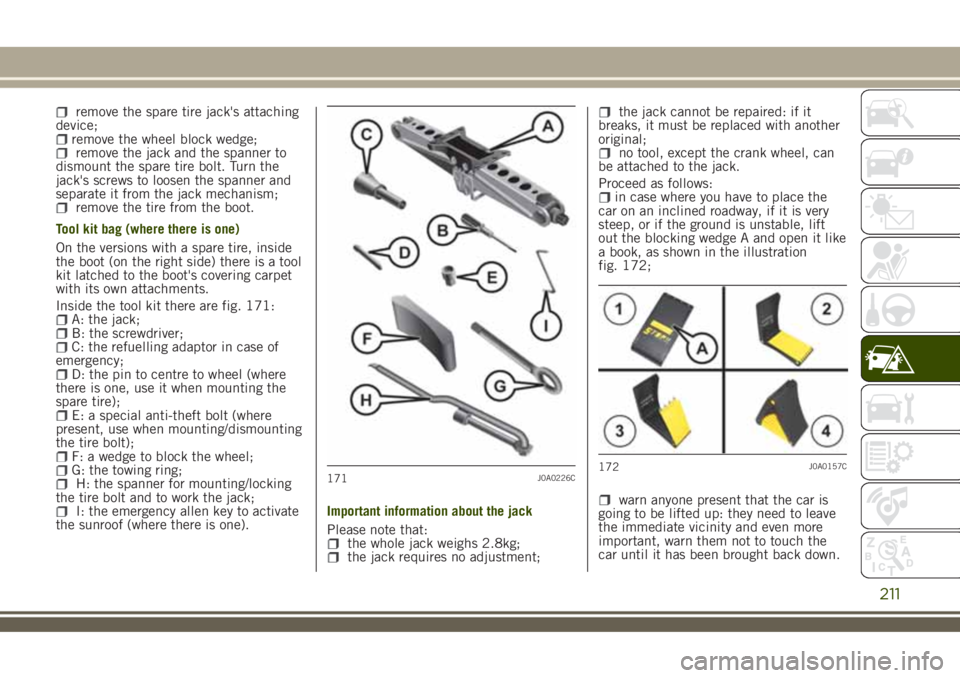
remove the spare tire jack's attaching
device;
remove the wheel block wedge;remove the jack and the spanner to
dismount the spare tire bolt. Turn the
jack's screws to loosen the spanner and
separate it from the jack mechanism;
remove the tire from the boot.
Tool kit bag (where there is one)
On the versions with a spare tire, inside
the boot (on the right side) there is a tool
kit latched to the boot's covering carpet
with its own attachments.
Inside the tool kit there are fig. 171:
A: the jack;B: the screwdriver;C: the refuelling adaptor in case of
emergency;
D: the pin to centre to wheel (where
there is one, use it when mounting the
spare tire);
E: a special anti-theft bolt (where
present, use when mounting/dismounting
the tire bolt);
F: a wedge to block the wheel;G: the towing ring;H: the spanner for mounting/locking
the tire bolt and to work the jack;
I: the emergency allen key to activate
the sunroof (where there is one).Important information about the jack
Please note that:
the whole jack weighs 2.8kg;the jack requires no adjustment;
the jack cannot be repaired: if it
breaks, it must be replaced with another
original;
no tool, except the crank wheel, can
be attached to the jack.
Proceed as follows:
in case where you have to place the
car on an inclined roadway, if it is very
steep, or if the ground is unstable, lift
out the blocking wedge A and open it like
a book, as shown in the illustration
fig. 172;
warn anyone present that the car is
going to be lifted up: they need to leave
the immediate vicinity and even more
important, warn them not to touch the
car until it has been brought back down.
171J0A0226C172J0A0157C
211
Page 214 of 356
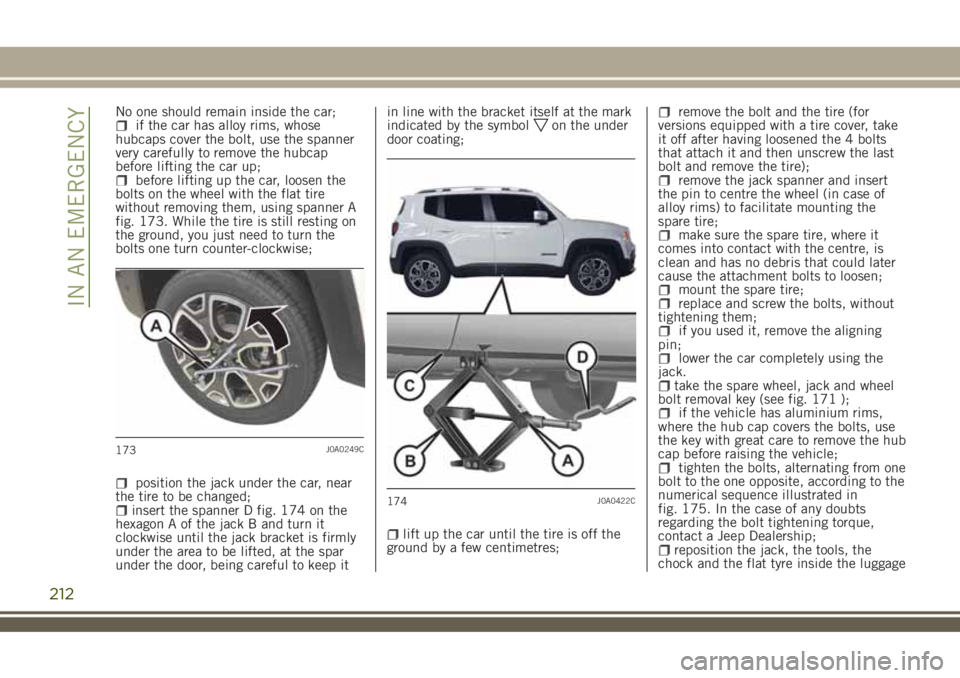
No one should remain inside the car;if the car has alloy rims, whose
hubcaps cover the bolt, use the spanner
very carefully to remove the hubcap
before lifting the car up;
before lifting up the car, loosen the
bolts on the wheel with the flat tire
without removing them, using spanner A
fig. 173. While the tire is still resting on
the ground, you just need to turn the
bolts one turn counter-clockwise;
position the jack under the car, near
the tire to be changed;
insert the spanner D fig. 174 on the
hexagon A of the jack B and turn it
clockwise until the jack bracket is firmly
under the area to be lifted, at the spar
under the door, being careful to keep itin line with the bracket itself at the mark
indicated by the symbol
on the under
door coating;
lift up the car until the tire is off the
ground by a few centimetres;
remove the bolt and the tire (for
versions equipped with a tire cover, take
it off after having loosened the 4 bolts
that attach it and then unscrew the last
bolt and remove the tire);
remove the jack spanner and insert
the pin to centre the wheel (in case of
alloy rims) to facilitate mounting the
spare tire;
make sure the spare tire, where it
comes into contact with the centre, is
clean and has no debris that could later
cause the attachment bolts to loosen;
mount the spare tire;replace and screw the bolts, without
tightening them;
if you used it, remove the aligning
pin;
lower the car completely using the
jack.
take the spare wheel, jack and wheel
bolt removal key (see fig. 171 );
if the vehicle has aluminium rims,
where the hub cap covers the bolts, use
the key with great care to remove the hub
cap before raising the vehicle;
tighten the bolts, alternating from one
bolt to the one opposite, according to the
numerical sequence illustrated in
fig. 175. In the case of any doubts
regarding the bolt tightening torque,
contact a Jeep Dealership;
reposition the jack, the tools, the
chock and the flat tyre inside the luggage
173J0A0249C
174J0A0422C
212
IN AN EMERGENCY
Page 215 of 356
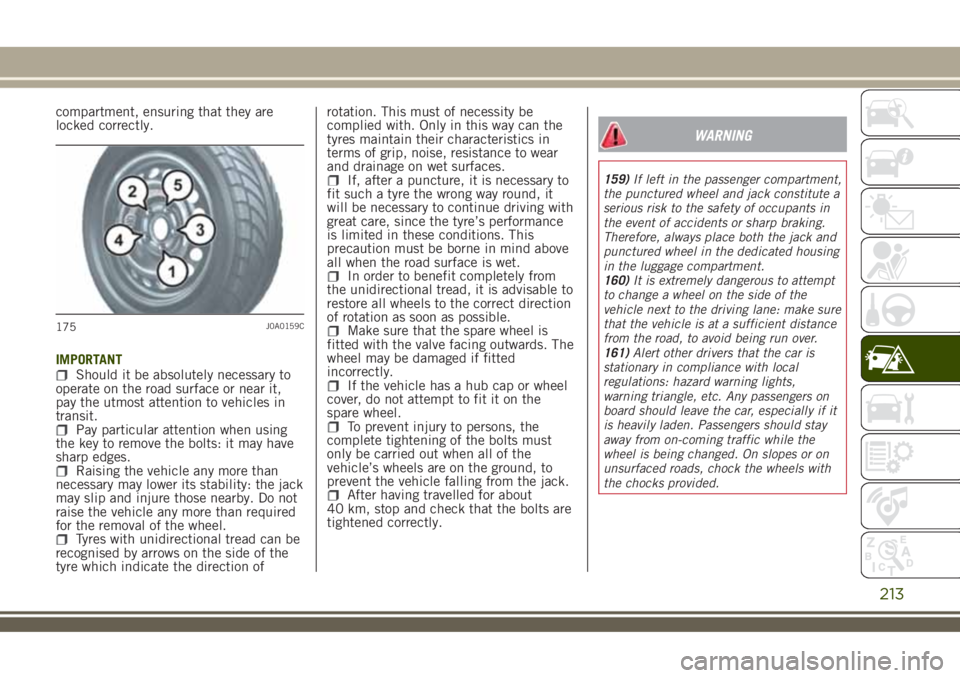
compartment, ensuring that they are
locked correctly.
IMPORTANT
Should it be absolutely necessary to
operate on the road surface or near it,
pay the utmost attention to vehicles in
transit.
Pay particular attention when using
the key to remove the bolts: it may have
sharp edges.
Raising the vehicle any more than
necessary may lower its stability: the jack
may slip and injure those nearby. Do not
raise the vehicle any more than required
for the removal of the wheel.
Tyres with unidirectional tread can be
recognised by arrows on the side of the
tyre which indicate the direction ofrotation. This must of necessity be
complied with. Only in this way can the
tyres maintain their characteristics in
terms of grip, noise, resistance to wear
and drainage on wet surfaces.
If, after a puncture, it is necessary to
fit such a tyre the wrong way round, it
will be necessary to continue driving with
great care, since the tyre’s performance
is limited in these conditions. This
precaution must be borne in mind above
all when the road surface is wet.
In order to benefit completely from
the unidirectional tread, it is advisable to
restore all wheels to the correct direction
of rotation as soon as possible.
Make sure that the spare wheel is
fitted with the valve facing outwards. The
wheel may be damaged if fitted
incorrectly.
If the vehicle has a hub cap or wheel
cover, do not attempt to fit it on the
spare wheel.
To prevent injury to persons, the
complete tightening of the bolts must
only be carried out when all of the
vehicle’s wheels are on the ground, to
prevent the vehicle falling from the jack.
After having travelled for about
40 km, stop and check that the bolts are
tightened correctly.
WARNING
159)If left in the passenger compartment,
the punctured wheel and jack constitute a
serious risk to the safety of occupants in
the event of accidents or sharp braking.
Therefore, always place both the jack and
punctured wheel in the dedicated housing
in the luggage compartment.
160)It is extremely dangerous to attempt
to change a wheel on the side of the
vehicle next to the driving lane: make sure
that the vehicle is at a sufficient distance
from the road, to avoid being run over.
161)Alert other drivers that the car is
stationary in compliance with local
regulations: hazard warning lights,
warning triangle, etc. Any passengers on
board should leave the car, especially if it
is heavily laden. Passengers should stay
away from on-coming traffic while the
wheel is being changed. On slopes or on
unsurfaced roads, chock the wheels with
the chocks provided.
175J0A0159C
213